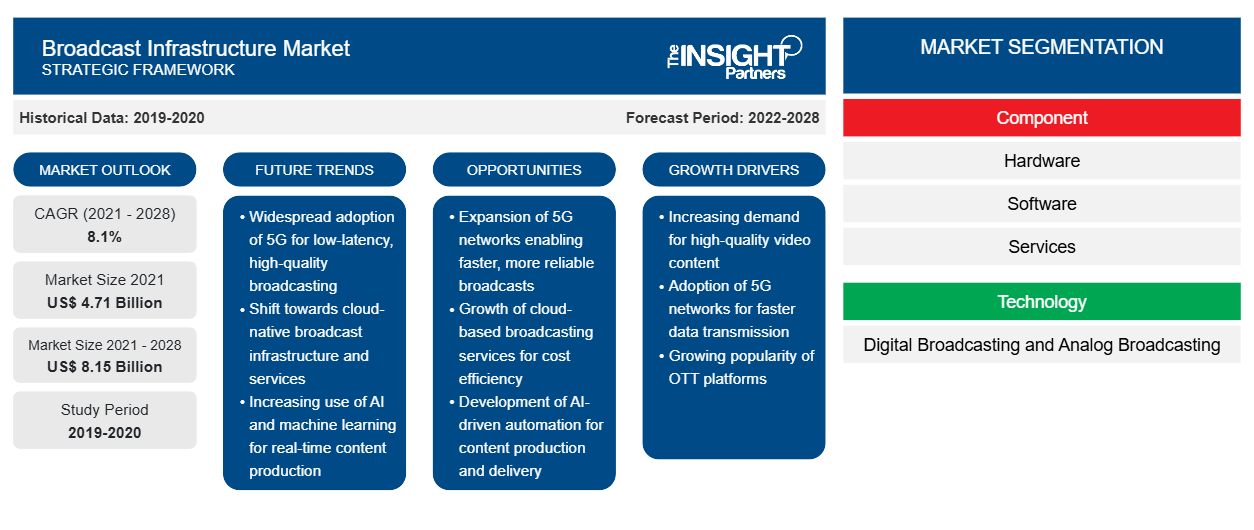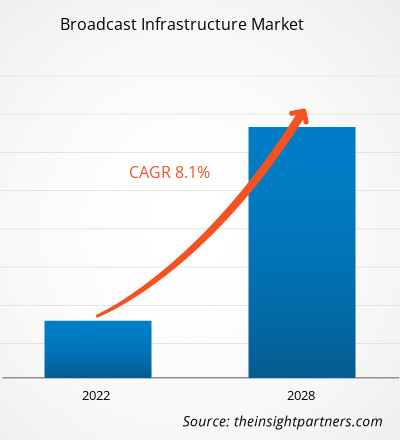[研究报告] 2021 年广播基础设施市场价值为 47.137 亿美元,预计到 2028 年将达到 81.457 亿美元;预计 2021 年至 2028 年的复合年增长率为 8.1%。
广播行业从模拟技术向数字技术的范式转变引入了先进的广播基础设施,这种基础设施相对复杂。广播行业对互联网协议电视 (IPTV)、网络电视、高清电视 (HDTV) 和按次付费等新广播技术的需求巨大。对丰富视频体验的需求预计将为全球尤其是亚洲的广播公司铺平道路。推动广播基础设施市场发展的另一个关键因素是集成平台,包括服务器、机顶盒和视频内容保护系统,以及适当的工具、中间件和计费,允许提供多种格式的各种电视服务,例如视频点播、流媒体和时移电视,这些服务基于底层 IP 网络和 DSL 或光纤接入系统的组合。如今,由于广播硬件基础设施成本高昂、维护成本高昂以及硬件升级频繁,供应商正在从基于硬件的基础设施转向基于软件的基础设施。广播行业一直在经历革命性的创新,技术的发展为用户提供更好的体验,并为广播基础设施供应商创造机会。
定制此报告以满足您的需求
您可以免费定制任何报告,包括本报告的部分内容、国家级分析、Excel 数据包,以及为初创企业和大学提供优惠和折扣
- 获取此报告的关键市场趋势。这个免费样品将包括数据分析,从市场趋势到估计和预测。
COVID-19 疫情对广播基础设施市场的影响
在 COVID-19 疫情期间,大量个人居家办公,花费更多时间上网,并推动数字化转型。对数字资源的这种需求进一步给许多软件和平台组织的系统带来压力,并阻碍了它们提供可靠和高质量服务的能力。然而,由于业务停工和劳动力短缺,COVID-19 疫情对参与向最终用户提供视频内容的参与者产生了负面影响。由于业务停工、旅行禁令和供应链中断,COVID-19 危机还彻底颠覆了整个价值链的运营,从供应商网络到客户交付体验。
市场洞察 – 广播基础设施市场
越来越多地采用新的广播技术
随着数字化的不断进步和可支配收入的增加,市场正在见证 IPTV 和 HDTV 的高普及率。对丰富视频体验的需求预计将为全球尤其是亚洲的广播公司铺平道路。由于按需消费者观看,亚太地区的宽带普及率正在提高。此外,Netflix 等基于订阅的 over-the-top (OTT) 平台在亚洲越来越受欢迎。政府对基于云的基础设施、基于云的解决方案和托管服务以及混合网络的支出增加预计将推动广播基础设施市场的增长。日益增长的安全问题和维护客户信任将鼓励广播公司采用新的交付模式。在预测期内,所有进步和发展都可能对市场增长产生积极影响。
基于组件的洞察
根据组件,广播基础设施市场分为硬件、软件和服务。软件部分在 2020 年占据了最大的市场份额。
广播基础设施市场区域洞察
Insight Partners 的分析师已详尽解释了预测期内影响广播基础设施市场的区域趋势和因素。本节还讨论了北美、欧洲、亚太地区、中东和非洲以及南美和中美洲的广播基础设施市场细分和地理位置。

- 获取广播基础设施市场的区域特定数据
广播基础设施市场报告范围
| 报告属性 | 细节 |
|---|---|
| 2021 年市场规模 | 47.1亿美元 |
| 2028 年市场规模 | 81.5亿美元 |
| 全球复合年增长率(2021 - 2028) | 8.1% |
| 史料 | 2019-2020 |
| 预测期 | 2022-2028 |
| 涵盖的领域 | 按组件
|
| 覆盖地区和国家 | 北美
|
| 市场领导者和主要公司简介 |
|
市场参与者密度:了解其对商业动态的影响
广播基础设施市场正在快速增长,这得益于终端用户需求的不断增长,而这些需求又源于消费者偏好的不断变化、技术进步以及对产品优势的认识不断提高等因素。随着需求的增加,企业正在扩大其产品范围,进行创新以满足消费者的需求,并利用新兴趋势,从而进一步推动市场增长。
市场参与者密度是指在特定市场或行业内运营的企业或公司的分布情况。它表明在给定市场空间中,相对于其规模或总市场价值,有多少竞争对手(市场参与者)存在。
在广播基础设施市场运营的主要公司有:
- 思科系统公司
- 克莱德广播技术公司
- CS 计算机系统有限公司
- Dacast 公司
- EVS 广播设备公司
免责声明:上面列出的公司没有按照任何特定顺序排列。

- 获取广播基础设施市场顶级关键参与者的概览
广播基础设施市场的参与者主要致力于开发先进、高效的产品。
- 2021 年 6 月,领先的广播和新媒体制作现场视频技术提供商 EVS 宣布与 Gravity Media 合作,提供 Xeebra 多摄像机审查系统作为该公司新的综合视频裁决和通信解决方案的核心技术。
- 2021 年 6 月,Ross Video 宣布收购媒体资产工作流程解决方案公司 Primestream。这些解决方案被各个垂直市场的客户使用,包括企业、数字媒体、体育和广播。他们的解决方案旨在解决每个市场中独特且日益复杂的创意、业务和技术挑战。通过此次收购,Ross 自然会寻求将其 Streamline 媒体资产管理解决方案与 Primestream 产品融合在一起,以创建一个完全融合的图形和制作资产管理平台。
广播基础设施市场细分如下:
广播基础设施市场 – 按组件划分
- 硬件
- 软件
- 服务
广播基础设施市场 – 按技术分类
- 数字广播
- 模拟广播
广播基础设施市场 – 按应用划分
- 互联网
- 陆地
- 卫星
- 网络电视
- 其他的
广播基础设施市场 – 按地区划分
- 北美
- 我们
- 加拿大
- 墨西哥
- 欧洲
- 德国
- 法国
- 意大利
- 英国
- 俄罗斯
- 欧洲其他地区
- 亚太地区 (APAC)
- 澳大利亚
- 中国
- 印度
- 日本
- 韩国
- 亚太地区其他地区
- 中东和非洲 (MEA)
- 沙特阿拉伯
- 阿联酋
- 南非
- MEA 其他地区
- 南美洲 (SAM)
- 巴西
- 阿根廷
- SAM 其余部分
广播基础设施市场 – 公司简介
- 思科系统公司
- 克莱德广播技术公司
- CS 计算机系统有限公司
- Dacast 公司
- EVS 广播设备公司
- 草谷
- 卡尔图拉
- 内维翁
- 罗斯影视有限公司
- 紫溪
- 历史分析(2 年)、基准年、预测(7 年)及复合年增长率
- PEST 和 SWOT 分析
- 市场规模价值/数量 - 全球、区域、国家
- 行业和竞争格局
- Excel 数据集


- Trade Promotion Management Software Market
- USB Device Market
- Hydrogen Compressors Market
- Real-Time Location Systems Market
- Smart Grid Sensors Market
- Emergency Department Information System (EDIS) Market
- Nuclear Waste Management System Market
- Airline Ancillary Services Market
- Neurovascular Devices Market
- Fill Finish Manufacturing Market

Report Coverage
Revenue forecast, Company Analysis, Industry landscape, Growth factors, and Trends

Segment Covered
This text is related
to segments covered.

Regional Scope
North America, Europe, Asia Pacific, Middle East & Africa, South & Central America

Country Scope
This text is related
to country scope.
常见问题
US led the broadcast infrastructure market globally with a market share of 68.7% in the year 2020. For instance, For instance in 2021, DigitalBridge Group, an American made an announcement to acquire a majority stake in Vertical Bridge, the largest operator of wireless communications infrastructure in the US with an aim to meet the rising demands for broadcast infrastructure solutions. Significant investments in the 5G infrastructure by the government of the US has created a tremendous long-term growth opportunities for telecommunications infrastructure in the region.
The major companies in broadcast infrastructure includes Computer System, Grass Valley, EVS Broadcast Equipment, Nevion, Kaltura, among others. The ranking has been derived analysing multiple parameters such as annual revenue earned from broadcast infrastructure portfolio, client base, geographic locations, R&D expenditure, brand image, and number of employees, among others. These companies are actively participating in developing broadcast infrastructure for various applications.
The broadcast infrastructures have been in use for several years worldwide, however, the technology has been experiencing immense demand in recent years. The noteworthy increasing adoption of new broadcast technologies and migration from hardware to software based infrastructure is supporting the growth of broadcast infrastructure market. Moreover, the demand for cloud-based solutions in the broadcast industry for low cost and high scalability increases, the opportunities for market players who provide cost-effective and efficient streaming will propel the growth of the market.
In 2020, North America led the market with a substantial revenue share, followed by Europe, and APAC. Asia Pacific is a prospective market for broadcast infrastructure market players.
Increasing demand of Digital Terrestrial TV (DTTV) is the key opportunity for the broadcast infrastructure market. Growing demand of smart TVs, and advancements in telecom and broadcast industry is anticipated to drive the growth of Digital Terrestrial Television (DTT). With increasing consumption of TV sets and expenditure on terrestrial networks for quality, entertainment, and family friendly purpose, the demand for DTT has boosted.
The global broadcast infrastructure market was dominated by terrestrial segment with market share of 44% in 2020. Terrestrial television refers to methods of television broadcasting which do not include satellite transmission or through underground cables. The transition to digital terrestrial TV from analog terrestrial TV can be considered a significant development for the broadcasting industry. While the implementation of digital broadcasting has been led by satellite, cable, and to some extent IPTV, it is the evolution of the terrestrial broadcast platform that perhaps brings most benefits to the society.
Trends and growth analysis reports related to Electronics and Semiconductor : READ MORE..
The List of Companies - Broadcast Infrastructure Market
- Cisco Systems, Inc.
- Clyde Broadcast Technology
- CS Computer Systems Ltd.
- Dacast Inc.
- EVS Broadcast Equipment SA
- Grass Valley
- Kaltura
- Nevion
- Ross Video Ltd
- Zixi
The Insight Partners performs research in 4 major stages: Data Collection & Secondary Research, Primary Research, Data Analysis and Data Triangulation & Final Review.
- Data Collection and Secondary Research:
As a market research and consulting firm operating from a decade, we have published and advised several client across the globe. First step for any study will start with an assessment of currently available data and insights from existing reports. Further, historical and current market information is collected from Investor Presentations, Annual Reports, SEC Filings, etc., and other information related to company’s performance and market positioning are gathered from Paid Databases (Factiva, Hoovers, and Reuters) and various other publications available in public domain.
Several associations trade associates, technical forums, institutes, societies and organization are accessed to gain technical as well as market related insights through their publications such as research papers, blogs and press releases related to the studies are referred to get cues about the market. Further, white papers, journals, magazines, and other news articles published in last 3 years are scrutinized and analyzed to understand the current market trends.
- Primary Research:
The primarily interview analysis comprise of data obtained from industry participants interview and answers to survey questions gathered by in-house primary team.
For primary research, interviews are conducted with industry experts/CEOs/Marketing Managers/VPs/Subject Matter Experts from both demand and supply side to get a 360-degree view of the market. The primary team conducts several interviews based on the complexity of the markets to understand the various market trends and dynamics which makes research more credible and precise.
A typical research interview fulfils the following functions:
- Provides first-hand information on the market size, market trends, growth trends, competitive landscape, and outlook
- Validates and strengthens in-house secondary research findings
- Develops the analysis team’s expertise and market understanding
Primary research involves email interactions and telephone interviews for each market, category, segment, and sub-segment across geographies. The participants who typically take part in such a process include, but are not limited to:
- Industry participants: VPs, business development managers, market intelligence managers and national sales managers
- Outside experts: Valuation experts, research analysts and key opinion leaders specializing in the electronics and semiconductor industry.
Below is the breakup of our primary respondents by company, designation, and region:

Once we receive the confirmation from primary research sources or primary respondents, we finalize the base year market estimation and forecast the data as per the macroeconomic and microeconomic factors assessed during data collection.
- Data Analysis:
Once data is validated through both secondary as well as primary respondents, we finalize the market estimations by hypothesis formulation and factor analysis at regional and country level.
- Macro-Economic Factor Analysis:
We analyse macroeconomic indicators such the gross domestic product (GDP), increase in the demand for goods and services across industries, technological advancement, regional economic growth, governmental policies, the influence of COVID-19, PEST analysis, and other aspects. This analysis aids in setting benchmarks for various nations/regions and approximating market splits. Additionally, the general trend of the aforementioned components aid in determining the market's development possibilities.
- Country Level Data:
Various factors that are especially aligned to the country are taken into account to determine the market size for a certain area and country, including the presence of vendors, such as headquarters and offices, the country's GDP, demand patterns, and industry growth. To comprehend the market dynamics for the nation, a number of growth variables, inhibitors, application areas, and current market trends are researched. The aforementioned elements aid in determining the country's overall market's growth potential.
- Company Profile:
The “Table of Contents” is formulated by listing and analyzing more than 25 - 30 companies operating in the market ecosystem across geographies. However, we profile only 10 companies as a standard practice in our syndicate reports. These 10 companies comprise leading, emerging, and regional players. Nonetheless, our analysis is not restricted to the 10 listed companies, we also analyze other companies present in the market to develop a holistic view and understand the prevailing trends. The “Company Profiles” section in the report covers key facts, business description, products & services, financial information, SWOT analysis, and key developments. The financial information presented is extracted from the annual reports and official documents of the publicly listed companies. Upon collecting the information for the sections of respective companies, we verify them via various primary sources and then compile the data in respective company profiles. The company level information helps us in deriving the base number as well as in forecasting the market size.
- Developing Base Number:
Aggregation of sales statistics (2020-2022) and macro-economic factor, and other secondary and primary research insights are utilized to arrive at base number and related market shares for 2022. The data gaps are identified in this step and relevant market data is analyzed, collected from paid primary interviews or databases. On finalizing the base year market size, forecasts are developed on the basis of macro-economic, industry and market growth factors and company level analysis.
- Data Triangulation and Final Review:
The market findings and base year market size calculations are validated from supply as well as demand side. Demand side validations are based on macro-economic factor analysis and benchmarks for respective regions and countries. In case of supply side validations, revenues of major companies are estimated (in case not available) based on industry benchmark, approximate number of employees, product portfolio, and primary interviews revenues are gathered. Further revenue from target product/service segment is assessed to avoid overshooting of market statistics. In case of heavy deviations between supply and demand side values, all thes steps are repeated to achieve synchronization.
We follow an iterative model, wherein we share our research findings with Subject Matter Experts (SME’s) and Key Opinion Leaders (KOLs) until consensus view of the market is not formulated – this model negates any drastic deviation in the opinions of experts. Only validated and universally acceptable research findings are quoted in our reports.
We have important check points that we use to validate our research findings – which we call – data triangulation, where we validate the information, we generate from secondary sources with primary interviews and then we re-validate with our internal data bases and Subject matter experts. This comprehensive model enables us to deliver high quality, reliable data in shortest possible time.


 获取此报告的免费样本
获取此报告的免费样本